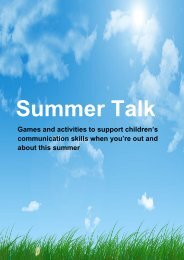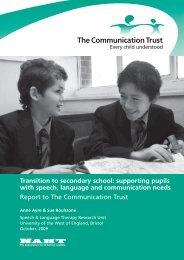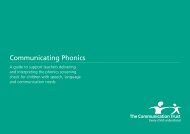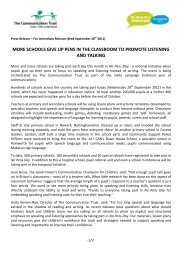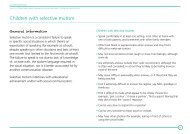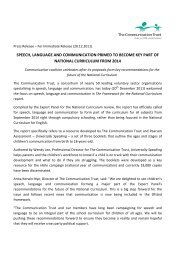Don't Get Me Wrong - The Communication Trust
Don't Get Me Wrong - The Communication Trust
Don't Get Me Wrong - The Communication Trust
You also want an ePaper? Increase the reach of your titles
YUMPU automatically turns print PDFs into web optimized ePapers that Google loves.
Specific advice to support children who have SLCN<br />
If they have difficulty expressing themselves<br />
• <br />
• <br />
Listen and show your interest by maintaining eye contact and using their name<br />
but be aware that excessive use of eye contact may be difficult for some children,<br />
particularly those with autism<br />
Be patient and let them know you will wait<br />
• Give positive feedback for effort<br />
• <br />
• <br />
• <br />
• <br />
• <br />
• <br />
• <br />
• <br />
• <br />
Build on what they have already said, follow their lead<br />
Increase opportunities for real dialogue and conversation, take short turns<br />
Sometimes you may have to say (kindly) that you cannot understand and<br />
perhaps there is another way to explain it<br />
Offer help and support when they ask for it<br />
Make sure they are not rushed or feeling rushed<br />
Do not correct, instead provide the right model of spoken language<br />
Respond to what they are trying to say rather than how<br />
Provide sentence frames with examples of how to use more complex language<br />
Prompt with cues such as ‘first’, ‘then’, ‘last’<br />
If someone stammers<br />
• Be calm and patient<br />
• <br />
• <br />
• <br />
Give them time to think before responding<br />
Allow them time to finish what they are saying rather than finishing their<br />
sentence for them<br />
Do not put pressure on them to speak or read aloud<br />
If communication is a problem<br />
• <br />
Explain the effect on the listener when social communication rules are broken<br />
and perhaps explore through role play<br />
• Praise good listening skills<br />
• <br />
• <br />
Encourage them to wait for a gap, or a clear signal from the speaker before joining in<br />
Encourage children to look at the non verbal cues which help us understand<br />
what the other person thinks and feels, for example when a person pauses,<br />
that means you can have a turn<br />
Don’t <strong>Get</strong> <strong>Me</strong> <strong>Wrong</strong> 35




